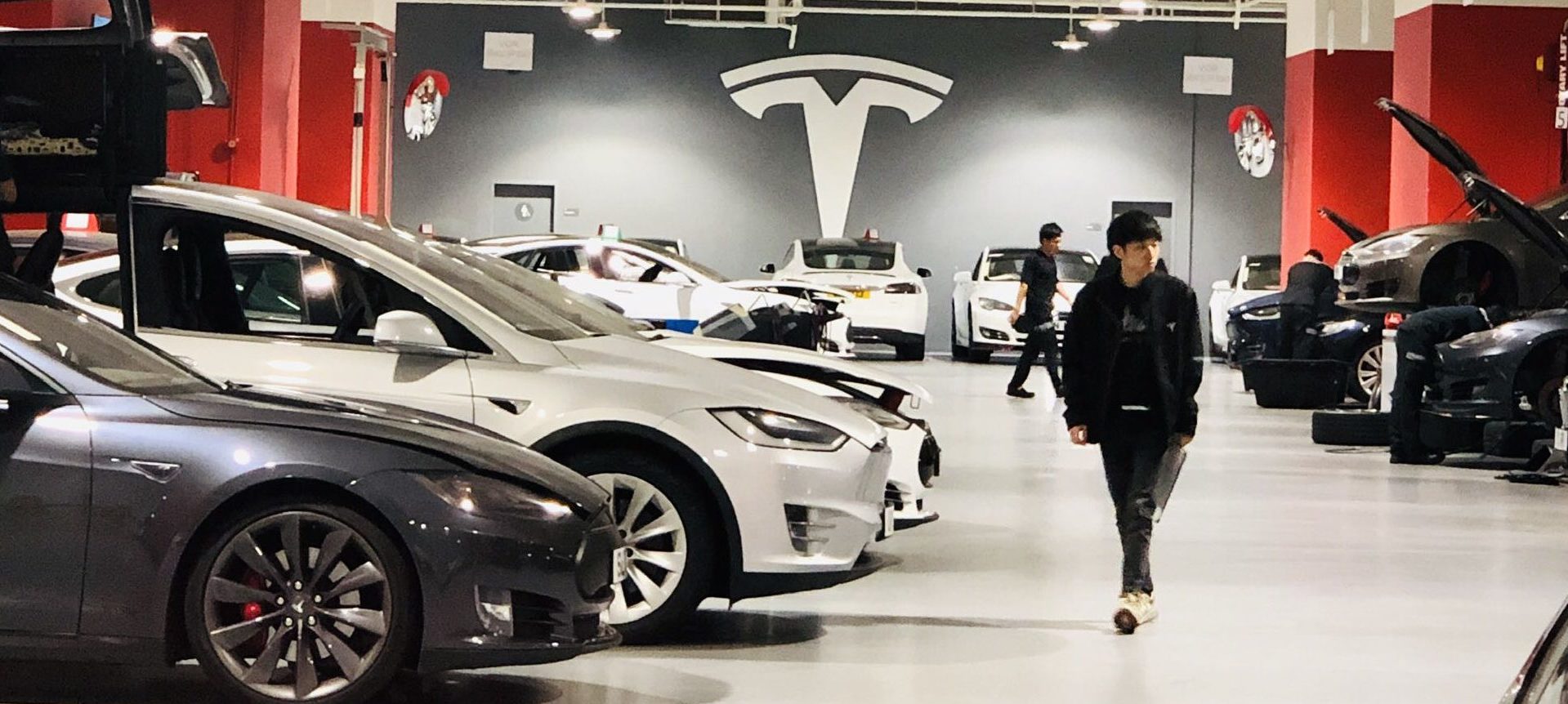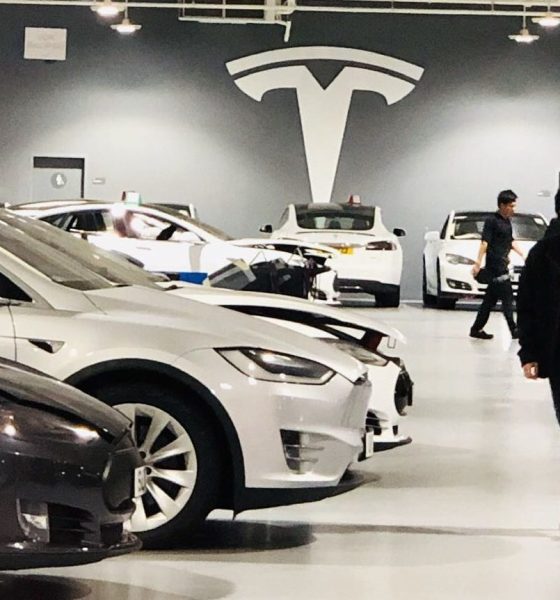

Investor's Corner
Tesla is addressing its repair service challenges by doubling capacity in 2019
As Tesla heads towards the mass market with vehicles like the Model 3 sedan and the upcoming Model Y SUV, the challenges of supporting an ever-growing fleet is becoming more and more evident. Over the past month, numerous Tesla owners, including influencers with large followings on social media, have brought up the issue of the company’s vehicle service problems. In its recent Update Letter and following earnings call, the electric car maker provided some insights into this issue.
Tesla stated that it is currently operating 378 service centers around the world by the end of the fourth quarter, with 300 of the sites being located outside of CA. Augmenting this support system is a fleet of 411 mobile service vehicles. While this might seem sufficient to provide service to the company’s Model S and Model X, these sites are quickly proving insufficient when faced with the company’s increasing sales and its ever-growing Model 3 fleet.
In 2018, for example, Tesla delivered 245,240 vehicles across the globe. This year, Tesla noted in its shareholder letter that it aims to increase vehicle deliveries to 360,000 to 400,000 worldwide — an increase of 45% to 65% compared to 2018’s already record-breaking numbers. With this in mind, there is a need for Tesla to ensure that its service capabilities are enough to support the company’s increasing number of vehicles.
During the recently held earnings call, Tesla noted that it would be rolling out vast improvements for its parts distribution systems. Elon Musk added that Tesla’s strategies for servicing vehicles have been pretty inadequate, at one point candidly describing the policies as “boneheaded.” Musk also noted that some of its service processes were “super dumb,” referring to a system where a part made in China gets shipped to the US, only to be sent back to China where they were ordered.
“We’re also improving parts distribution. I think we made a strategic error in the past about not having service parts located at our distribution centers. We had them in parts distribution warehouses which basically meant it was impossible to have a fast turnaround on service on your car because the car would come in, then the parts would be requested (before) they come to the service center. Basically, for even for a very simple repair, it could take days.
“We’re going to move to stocking all common parts at the service centers, so it’s possible to get your car service in 20 or possibly 15 minutes. Lightning fast. It’s also gonna make sense for our service centers to do basic bodywork or essentially if all you need to do is replace a front or rear feature, it makes sense to pre-stock the front-rear feature in the common colors. So unless you have (an) unusual color, we can literally replace your feature in 15-20 minutes, and there’s none of this like weeks at a body shop stuff.”
One thing that the company emphasized in the earnings call was the potential of its Tesla Rangers service, which sends certified mechanics to customers’ homes or offices to repair cars on the spot. Considering that the Rangers could address around 80% of repairs needed for Tesla’s electric cars, a serious ramp of the mobile service would likely result in an improvement for the company’s vehicle service systems.
In its Q4 2018 Update Letter, the company noted that its centers would be moving to two-shift operations in order to double the capacity of a site. Improvements to the Tesla app are also expected to make scheduling service an easy and seamless affair. Ultimately, these initiatives are expected to allow the electric car maker to vastly improve its capabilities to address its owners’ vehicle concerns.
Tesla’s areas for improvement in its service systems appear to be a notable topic for Elon Musk. In last year’s Annual Shareholder Meeting, Musk announced that Tesla is opening in-house body shops to reduce the time it takes for vehicles to be repaired. Tesla eventually launched several in-house repair centers across the United States, and the reception from the community has largely been positive. Model 3 owner and YouTube influencer Kim of Like Tesla, for one, shared her experience with one of the company’s in-house body shops, which was able to complete the repairs to her damaged vehicle in 24 hours.

Investor's Corner
Tesla price target boost from its biggest bear is 95% below its current level

Tesla stock (NASDAQ: TSLA) just got a price target boost from its biggest bear, Gordon Johnson of GLJ Research, who raised his expected trading level to one that is 95 percent lower than its current trading level.
Johnson pushed his Tesla price target from $19.05 to $25.28 on Wednesday, while maintaining the ‘Sell’ rating that has been present on the stock for a long time. GLJ has largely been recognized as the biggest skeptic of Elon Musk’s company, being particularly critical of the automotive side of things.
Tesla has routinely been called out by Johnson for negative delivery growth, what he calls “weakening demand,” and price cuts that have occurred in past years, all pointing to them as desperate measures to sell its cars.
Johnson has also said that Tesla is extremely overvalued and is too reliant on regulatory credits for profitability. Other analysts on the bullish side recognize Tesla as a company that is bigger than just its automotive side.
Many believe it is a leader in autonomous driving, like Dan Ives of Wedbush, who believes Tesla will have a widely successful 2026, especially if it can come through on its targets and schedules for Robotaxi and Cybercab.
Justifying the price target this week, Johnson said that the revised valuation is based on “reality rather than narrative.” Tesla has been noted by other analysts and financial experts as a stock that trades on narrative, something Johnson obviously disagrees with.
Dan Nathan, a notorious skeptic of the stock, turned bullish late last year, recognizing the company’s shares trade on “technicals and sentiment.” He said, “From a trading perspective, it looks very interesting.”
Tesla bear turns bullish for two reasons as stock continues boost
Johnson has remained very consistent with this sentiment regarding Tesla and his beliefs regarding its true valuation, and has never shied away from putting his true thoughts out there.
Tesla shares closed at $431.40 today, about 95 percent above where Johnson’s new price target lies.
Investor's Corner
Tesla gets price target bump, citing growing lead in self-driving

Tesla (NASDAQ: TSLA) stock received a price target update from Pierre Ferragu of Wall Street firm New Street Research, citing the company’s growing lead in self-driving and autonomy.
On Tuesday, Ferragu bumped his price target from $520 to $600, stating that the consensus from the Consumer Electronics Show in Las Vegas was that Tesla’s lead in autonomy has been sustained, is growing, and sits at a multiple-year lead over its competitors.
CES 2026 validates Tesla’s FSD strategy, but there’s a big lag for rivals: analyst
“The signal from Vegas is loud and clear,” the analyst writes. “The industry isn’t catching up to Tesla; it is actively validating Tesla’s strategy…just with a 12-year lag.”
The note shows that the company’s prowess in vehicle autonomy is being solidified by lagging competitors that claim to have the best method. The only problem is that Tesla’s Vision-based approach, which it adopted back in 2022 with the Model 3 and Model Y initially, has been proven to be more effective than competitors’ approach, which utilizes other technology, such as LiDAR and sensors.
Currently, Tesla shares are sitting at around $433, as the company’s stock price closed at $432.96 on Tuesday afternoon.
Ferragu’s consensus on Tesla shares echoes that of other Wall Street analysts who are bullish on the company’s stock and position within the AI, autonomy, and robotics sector.
Dan Ives of Wedbush wrote in a note in mid-December that he anticipates Tesla having a massive 2026, and could reach a $3 trillion valuation this year, especially with the “AI chapter” taking hold of the narrative at the company.
Ives also said that the big step in the right direction for Tesla will be initiating production of the Cybercab, as well as expanding on the Robotaxi program through the next 12 months:
“…as full-scale volume production begins with the autonomous and robotics roadmap…The company has started to test the all-important Cybercab in Austin over the past few weeks, which is an incremental step towards launching in 2026 with important volume production of Cybercabs starting in April/May, which remains the golden goose in unlocking TSLA’s AI valuation.”
Tesla analyst breaks down delivery report: ‘A step in the right direction’
Tesla has transitioned from an automaker to a full-fledged AI company, and its Robotaxi and Cybercab programs, fueled by the Full Self-Driving suite, are leading the charge moving forward. In 2026, there are major goals the company has outlined. The first is removing Safety Drivers from vehicles in Austin, Texas, one of the areas where it operates a ride-hailing service within the U.S.
Ultimately, Tesla will aim to launch a Level 5 autonomy suite to the public in the coming years.
Investor's Corner
Tesla Q4 delivery numbers are better than they initially look: analyst
The Deepwater Asset Management Managing Partner shared his thoughts in a post on his website.

Longtime Tesla analyst and Deepwater Asset Management Managing Partner Gene Munster has shared his insights on Tesla’s Q4 2025 deliveries. As per the analyst, Tesla’s numbers are actually better than they first appear.
Munster shared his thoughts in a post on his website.
Normalized December Deliveries
Munster noted that Tesla delivered 418k vehicles in the fourth quarter of 2025, slightly below Street expectations of 420k but above the whisper number of 415k. Tesla’s reported 16% year-over-year decline, compared to +7% in September, is largely distorted by the timing of the tax credit expiration, which pulled forward demand.
“Taking a step back, we believe September deliveries pulled forward approximately 55k units that would have otherwise occurred in December or March. For simplicity, we assume the entire pull-forward impacted the December quarter. Under this assumption, September growth would have been down ~5% absent the 55k pull-forward, a Deepwater estimate tied to the credit’s expiration.
“For December deliveries to have declined ~5% year over year would imply total deliveries of roughly 470k. Subtracting the 55k units pulled into September results in an implied December delivery figure of approximately 415k. The reported 418k suggests that, when normalizing for the tax credit timing, quarter-over-quarter growth has been consistently down ~5%. Importantly, this ~5% decline represents an improvement from the ~13% declines seen in both the March and June 2025 quarters.“
Tesla’s United States market share
Munster also estimated that Q4 as a whole might very well show a notable improvement in Tesla’s market share in the United States.
“Over the past couple of years, based on data from Cox Automotive, Tesla has been losing U.S. EV market share, declining to just under 50%. Based on data for October and November, Cox estimates that total U.S. EV sales were down approximately 35%, compared to Tesla’s just reported down 16% for the full quarter. For the first two months of the quarter, Cox reported Tesla market share of roughly a 65% share, up from under 50% in the September quarter.
“While this data excludes December, the quarter as a whole is likely to show a material improvement in Tesla’s U.S. EV market share.“








